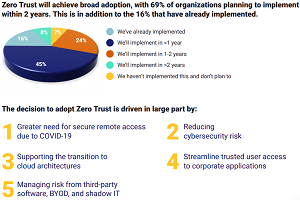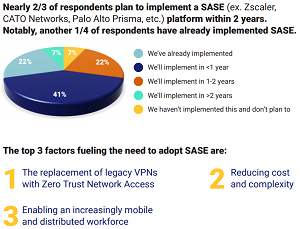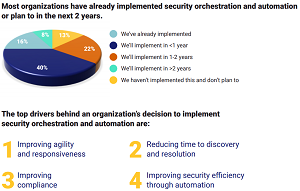News
What's the Future of Network Security? Zero Trust, SASE & Automation
Executives at large organizations were surveyed about their thoughts on what's coming for network security, revealing that top-of-mind concerns include Zero Trust, Secure Access Service Edge (SASE), automation and more.
The survey, "The Future of Network Security," was conducted by FireMon, which offers a security policy platform for firewalls and cloud security groups, and Pulse Media, a social research platform/knowledge community with more than 27,000 members. They polled 500 directors, vice presidents and C-Suite execs involved in IT security for organizations of between 1,001 to 10,000-plus employees.
Completed in January, the survey was conducted to learn:
- How respondents’ network security operations have changed as a result of major trends
- The solutions they’re planning to implement in the next 12 months
- The most critical initiatives they’re launching to optimize their network security posture
Those "major trends" mentioned in item No. 1 above include:
- Always-on always-multiplying threats
- Skyrocketing complexity caused by accelerated adoption of cloud/hybrid networks
- A pandemic-fueled explosion in the permanently distributed and remote workforce
- Business demands for an ever-increasing drive for agility, speed of innovation, and impeccable user experiences
Here's a snapshot of findings concerning Zero Trust, SASE and automation:
Zero Trust
The need for this trust model, along with SASE, was driven by the Solarwinds attack, the survey indicated.
It was also driven by the trend toward more distributed workforces, many of which have gone mobile, and the increased role of cloud-based applications. Some 86 percent of respondents report they have already implemented a Zero Trust Architecture (ZTA) or plan to do so in the next two years.
 [Click on image for larger view.] Embracing Zero Trust (source: FireMon/Pulse Media).
[Click on image for larger view.] Embracing Zero Trust (source: FireMon/Pulse Media).
SASE
This rising star in the security space was coined by research firm Gartner, describing a way to simplify wide-area networking and security by delivering both of those as a cloud service directly to the source of connection instead of the enterprise datacenter, according to Wikipedia.
 [Click on image for larger view.] Embracing SASE (source: FireMon/Pulse Media).
[Click on image for larger view.] Embracing SASE (source: FireMon/Pulse Media).
The survey indicates this and Zero Trust, among other things, mitigate the ability of malware to spread across networks. Examples of SASE implementation vendors include Zscalar, CATO Networks and Palo Alto Prisma. Almost two-thirds of respondents report they will implement such offerings with two years, with about 25 percent of organizations already doing so.
Automation
Nearly 80 percent of respondents indicate their organizations will implement security orchestration and automation in the next two years. What's more, almost all (98 percent) have already implemented automated security policies in some manner.
 [Click on image for larger view.] Amping Up Automation (source: FireMon/Pulse Media).
[Click on image for larger view.] Amping Up Automation (source: FireMon/Pulse Media).
The survey further explored security policies (a specialty of FireMon), finding that more than 9 in 10 organizations agree that network security policy management (NSPM) is a strategic investment to help them improve speed and responsiveness, though only 9 percent have completely automated their security policies.
Other major themes of the report include addressing security/dev misalignment and managing accelerating heterogeneity.
"Zero Trust Architecture, edge-based protection, security automation, particularly for more efficient management of network security policies, plus a preference for best-of-breed security technology with API-based capabilities are the primary areas where network security leaders' priorities are converging," the survey concluded.
"These priorities point to the importance of managing the accelerating heterogeneity of network security environments. COVID-19 has been a catalyst, however, the change we see in network security has been long in the making. This study illustrates the importance each of these components plays while integrating them into a cohesive security strategy for today and well into the future."
More survey results, commentary and methodology can be found in the report, which can be accessed here upon providing registration information.
About the Author
David Ramel is an editor and writer at Converge 360.